
While an entire tackle set-up is key to landing your fish of choice, few will argue the importance of using the right fishing line for each situation or application.
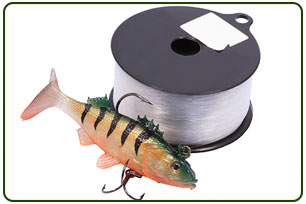
Fishing lines come in many forms with varying characteristics. Some of the most common types of fishing lines include monofilament line, fluorocarbon line, braided line, fly line, lead core line and wire line. Here is some basic info on the various types of fishing lines.
 Environmental Alert: To protect fish, wildlife and the environment, always take any discarded line with you when you leave. Discarded line can snag and harm wildlife and kill fish, turtles, frogs, birds and small mammals.
Environmental Alert: To protect fish, wildlife and the environment, always take any discarded line with you when you leave. Discarded line can snag and harm wildlife and kill fish, turtles, frogs, birds and small mammals.
What Does Pound Test Mean?
A “pound-test” rating is applied to many types of fishing line, and, in common terms, is essentially the amount of weight, force or pressure that a specific line is designed to withstand before breaking. However, this rating, in reality, may end up being more or less than the number set by a fishing line manufacturer when you take into account an anglers’ rod characteristics, reel and drag settings, lure choice and the aquatic environment that they are fishing in.
For example, an angler fishing with 6-pound test line in open water with a medium power rod, a loose drag setting and a lightweight lure may actually see a line strength much greater than 6 pounds. On the contrary, the same angler using 6-pound test line around submerged rocks with a heavy power rod, a tight drag setting and a heavy lure will tend to see an actual line strength much closer to the prescribed pound test rating of 6 pounds.
Types of Fishing Lines
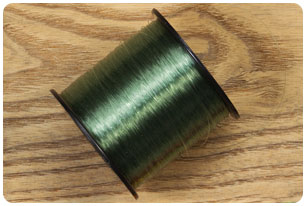 Monofilament Line
Monofilament Line
Made in a variety of colors, strengths and diameters, monofilament fishing line has a long history in sport fishing and is generally known for its ease of use, affordable cost and all-around value. Monofilament lines, made of a single strand of synthetic plastic material, generally stretch more than fluorocarbon or braided lines, and also tend to float more than fluorocarbon line.
Since monofilament tends to degrade quicker than other lines from heat, sun and water exposure, anglers should consider changing their monofilament line on a regular basis in order to achieve maximum performance out of their line.
- When to use: Though still used for a wide variety of applications, monofilament lines are becoming used more for technique-specific fishing approaches such as top water lure fishing or crankbait fishing where the line’s buoyancy and stretch traits can be best utilized.
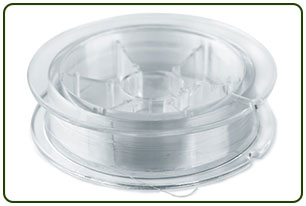 Fluorocarbon Line
Fluorocarbon Line
Though generally more expensive than monofilament fishing line, fluorocarbon line possesses several different, and in some cases superior, characteristics. Fluorocarbon line is a more rigid line which enables it to provide anglers with greater sensitivity of fish strikes, bottom composition and underwater habitat, as well as better hook sets.
Fluorocarbon line is renowned for its refractive index – or ability to disappear in the water and remain more invisible to fish. It also differs from monofilament and braided lines in that it is much denser and tends to be far less buoyant.
- When to use: While fluorocarbon lines have become very popular among anglers seeking enhanced sensitivity, strength and dissolvability in a single line, they are less advantageous for tactics that require a more buoyant or stretchy line such as monofilament fishing line. Like other lines, fluorocarbon is also available in a wide variety of strengths and diameters, as well as several hues.
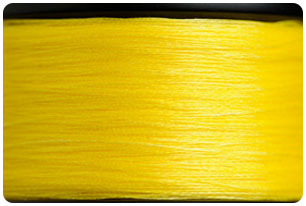 Braided Line
Braided Line
Perhaps one of the oldest types of fishing line, braided line is well-known for its high strength, durability, abrasion resistance, lack of stretch and overall power in respect to its diameter. While at one time braided lines were composed of natural materials, they are now made of braided or woven synthetic fibers.
While some types of braided line have been designed to remain somewhat invisible in water, most types are highly visible.
- When to use: Braided lines are most commonly used by anglers fishing around heavy aquatic cover such as underwater vegetation or submerged wood, in murky or discolored bodies of water and as backing to more subtle fluorocarbon or monofilament leaders.
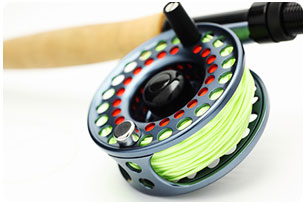 Fly Line
Fly Line
Typically consisting of a braided or monofilament core surrounded by a plastic covering, fly lines are made in both floating and sinking styles to allow for varying flies and presentations. A fly line’s outer covering, which comes in various colors and materials, generally defines the line’s shape, weight and buoyancy, while the inner core materials factor more into the line’s strength and flexibility.
In contrast to other types of fishing lines that are described in pound-test ratings, fly line is typically described in various weights – the measured amount in grains of the first 30 feet of the line. Fly line weights, in most cases, are designed to match the various weights of different fly fishing rods.
While anglers choose to use different weight lines for various reasons, generally speaking a specific weight fly fishing rod is made to accommodate the matching fly line weight.
- Leader: Usually made of monofilament or fluorocarbon fishing line, the leader connects the main fly line to the tippet material. Leaders are typically designed to taper from a heavier weight rating at the connection point with the main fly line, to a lower weight rating at the connection point to the tippet.
- Tippet: Tippet material is the section of lightweight line material, typically monofilament or fluorocarbon, which connects the leader to the fly. Tippet material, in conjunction with the leader, is designed to allow for a subtle fly presentation away from the main fly line.
- When to use: Anglers use different leader and tippet combinations depending on the fish species they are targeting and the type of aquatic structure they are fishing around. In some scenarios, such as while targeting fish with sharp, destructive teeth, anglers will employ a “shock” tippet comprised of steel or heavy-duty monofilament or fluorocarbon material.
Lead Core Line
Lead core line is a unique type of fishing line essentially consisting of a run of lead core wrapped in a nylon jacket or cover. Due to its heavy weight, this type of line is extremely popular among anglers looking to present lures into deeper parts of the water column and has become a widely used tool for trolling anglers targeting walleye, trout and salmon, among other species.
Wire Line
Wire line, which is often employed as a leader material, is commonly used by anglers targeting fish with sharp, destructive teeth that may easily break some of the more common forms of fishing line, and by trolling anglers looking for a heavier line in order to properly present lures into deeper parts of the water column. Typically made of stainless steel, titanium, copper or other metal allows, wire fishing line is available in a wide variety of compositions, strengths and colors or finishes.
For more information about the various types of fishing lines, visit www.takemefishing.org.
